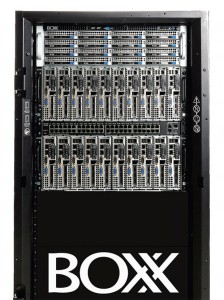Dump the Hassles: Collaborate Visually
Latest News
August 18, 2015
 Dear Desktop Engineering Reader:
Dear Desktop Engineering Reader:
Whether it’s clients with fuzzy demands or non-engineer types with budget control, you enter a design review knowing they will pepper you with a zillion questions, some good and some off-base. Today’s Check it Out link takes you to a paper with what you need to know to minimize such unpleasantness while simultaneously improving your design and collaboration processes.
“Making the Case for Visual Collaboration,” created by my Desktop Engineering colleagues in partnership with BOXX Technologies, offers a sensible solution to that bedeviling scene when you have to explain your design intent before your idea exists in the physical world: Visual collaboration through photorealistic rendering.
This nine-page paper argues and demonstrates that technological advances have made photorealistic rendering a practical medium for visual-based collaboration with stakeholders throughout the design through manufacture process. The scoop here is that you can now afford to show collaborators your design in vivid color residing and operating in its intended setting, which should seriously minimize the hassle of your “show me what you got” meetings.
Moreover, you can create renderings efficiently. See, the horsepower and software tools for quality photorealistic renderings are at a price and usability point that enables widespread usage by design engineers. This means you can make renderings early, often and in response to feedback. That keeps everyone in the loop, fosters ideation as well as innovation and reduces the chances of expensive eleventh hour changes.
This paper describes a number of hardware options, including a workstation tuned for quick renders, desk-side appliances that handle offloaded renderings and a full-blown RenderFarm On Wheels that can accommodate up to 2,880 cores for dedicated, big-time rendering jobs. The latter is a truly neat thing. A sidebar on the differences between rendering with a CPU and a GPU (graphics processing unit) is brilliant.
 The BOXX RenderFarm On Wheels, shown here in its 24U version, can accommodate up to 80 rendering modules with up to 2,880 cores in a 42U rack for high-volume, intense rendering applications. Image courtesy of BOXX Technologies.
The BOXX RenderFarm On Wheels, shown here in its 24U version, can accommodate up to 80 rendering modules with up to 2,880 cores in a 42U rack for high-volume, intense rendering applications. Image courtesy of BOXX Technologies.Three case studies demonstrate how real-world engineers use visual collaboration to communicate design intent, improve design processes and nurture innovation. The strength of the paper lies here because it presents the potential of visual collaboration technologies in a manner readily grasped by all audiences, technical or not.
You’re going to learn a lot reading “Making the Case for Visual Collaboration.” It makes so much sense. More importantly, you’ll get a tool that’ll make your case that now is the time for your outfit to get real about photorealistic rendering and collaboration. Hit today’s Check it Out link to download your copy.
Thanks, Pal. – Lockwood
Anthony J. Lockwood
Editor at Large, Desktop Engineering
Subscribe to our FREE magazine, FREE email newsletters or both!
Latest News
About the Author
Anthony J. Lockwood is Digital Engineering’s founding editor. He is now retired. Contact him via [email protected].
Follow DE





